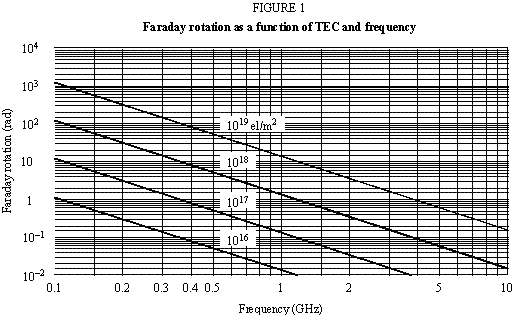|

Interaction with the Ionosphere, effects in EME
This project of research is
focusing on the Faraday effect and Ionospheric
interaction in EME Amateur Radio communication. Our aim is relating the
Faraday effect with Space wheater conditions,
geomagnetic indices and geographical location.
Abstract: Faraday rotation
in the ionosphere
(Courtesy : ITU
Recommendation ITU-R P.531-11-
02-2012)
When propagating through the ionosphere, a linearly
polarized wave will suffer a gradual rotation of its plane of polarization
due to the presence of the geomagnetic field and the anisotropy of the
plasma medium. The magnitude of Faraday rotation, q, will
depend on the frequency of the radiowave, the
magnetic field strength, and the electron density of the plasma as:
Ф=2,36 * 10^-14 * Bav NT/f²
where:
Ф: angle
of rotation (rad)
Bav : average Earth magnetic field (Wb × m–2 or Teslas)
f : frequency (GHz)
NT : TEC (electrons
× m–2).
Typical
values of q are shown in Fig. 1.

The Faraday
rotation is thus inversely proportional to the square of frequency and directly
proportional to the integrated product of the electron density and the
component of the Earth's magnetic field along the propagation path. Its
median value at a given frequency exhibits a very regular diurnal,
seasonal, and solar cyclical behaviour that can be predicted. This regular
component of the Faraday rotation can therefore be compensated for by a
manual adjustment of the polarization tilt angle at the earth-station
antennas. However, large deviations from this regular behaviour can occur for
small percentages of the time as a result of geomagnetic storms and, to a
lesser extent, large-scale travelling ionospheric
disturbances. These deviations cannot be predicted in advance. Intense and
fast fluctuations of the Faraday rotation angles of VHF signals have been
associated with strong and fast amplitude scintillations respectively, at
locations situated near the crests of the equatorial anomaly.
Amateur
Radio Research and propagation Studies: more
updates are available here: Document
Contact:
[email protected]
Copyright 2013 © Amateur Radio Propagation Studies. All
rights reserved.
WEBSITE
POLICY : The scientific researches issued in this site are exclusively
related to Amateur Radio experiments and studies and are not for profit or
commercial use
|
 Research in progress: Interaction with the Ionosphere, effects in EME
Research in progress: Interaction with the Ionosphere, effects in EME
